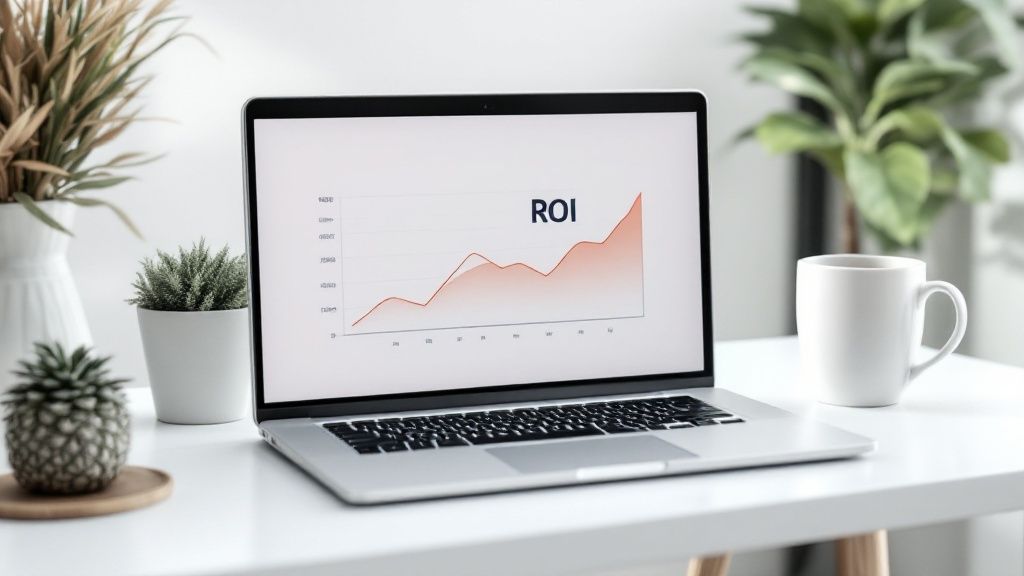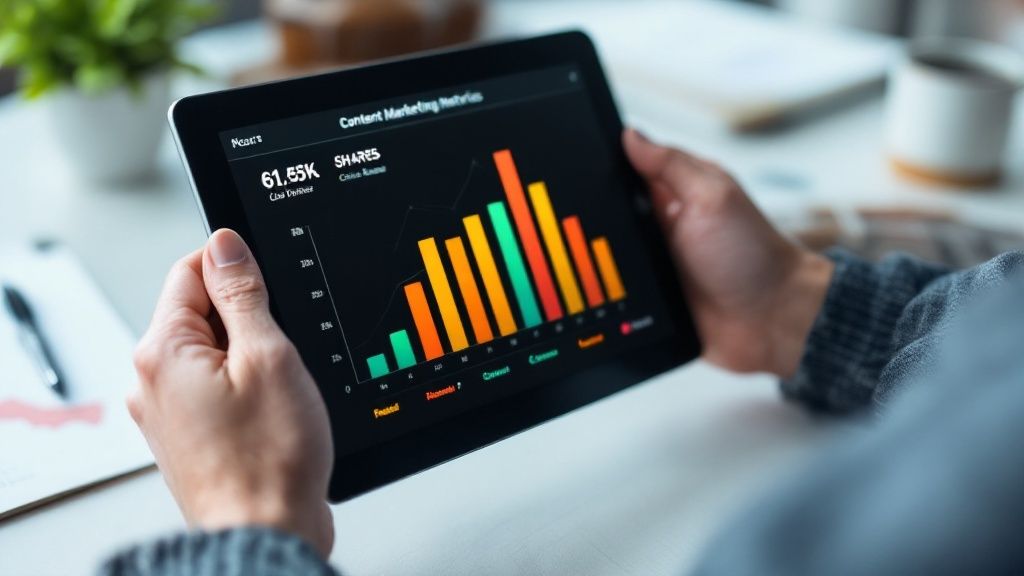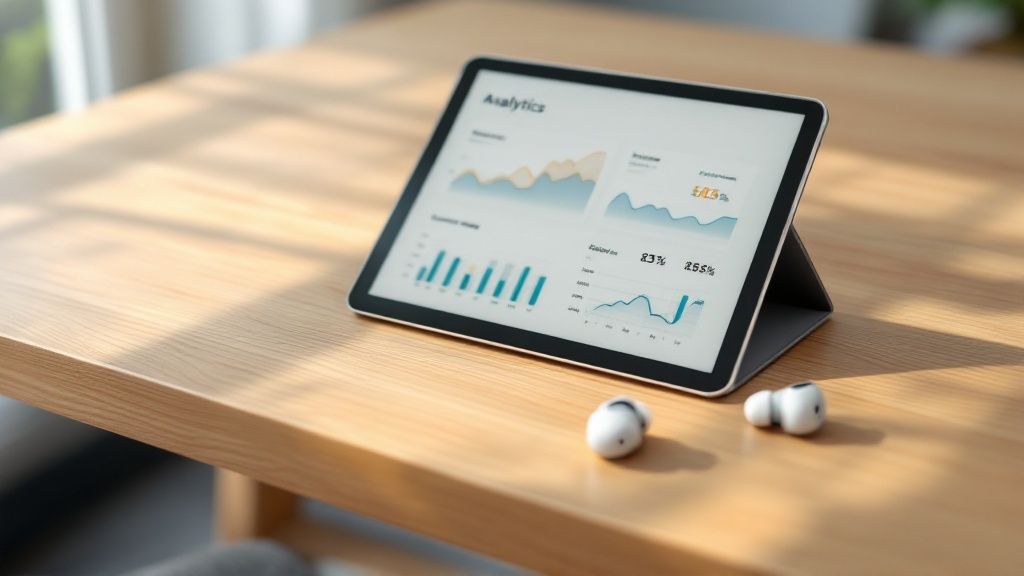Content marketing is no longer just about creating beautiful things. It’s about building a revenue engine. Measuring content marketing ROI is the discipline of connecting the dots between your blog posts, videos, and social campaigns and the tangible business outcomes they generate, from lead generation and brand awareness to customer retention. It’s how you prove your content isn’t a cost center—it’s a growth driver.
Why Proving Content ROI Is Non-Negotiable

Let’s be real for a moment. Proving the value of your content often feels like a constant struggle. For a long time, marketers got by celebrating page views and social shares. But now, leadership is asking a much tougher, and frankly, more important question: “What business did that blog post actually generate?”
This pivot from tracking activity to measuring impact is precisely why content marketing ROI has become absolutely essential. It’s not just a “nice-to-have” report anymore; it’s a core discipline for any serious marketing team. When you can clearly demonstrate a return on investment, you gain the power to secure bigger budgets, earn trust from stakeholders, and make genuinely smarter decisions for the future.
From Vanity Metrics to Business Impact
The most successful marketing teams have all made a crucial mental shift. They’ve stopped obsessing over surface-level metrics and now focus on tying every single piece of content back to a tangible business outcome. This focus on accountability isn’t just a hunch; the data backs it up. Many recent marketing ROI statistics show a clear trend: budgets are increasingly tied to past performance, making ROI the ultimate currency for marketing leaders.
To get there, you have to move beyond old-school thinking. It’s time to build a modern measurement framework.
Key Pillars of Modern Content ROI Measurement
This table breaks down the shift from traditional, often superficial metrics to the modern, ROI-focused metrics that actually matter to the business.
| Pillar | Traditional Metric | Modern ROI-Focused Metric |
|---|---|---|
| Lead Generation | Total Leads | Marketing Qualified Leads (MQLs) & Sales Qualified Leads (SQLs) |
| Audience Engagement | Page Views, Time on Page | Conversion Rate, Pipeline Contribution |
| Sales Influence | Last-Touch Attribution | Multi-Touch Attribution, Customer Lifetime Value (CLV) |
| Cost Efficiency | Cost Per Post | Cost Per Acquisition (CPA), Customer Acquisition Cost (CAC) |
Ultimately, this modern approach helps you tell a story with data—a story that shows how your content directly fuels business growth, not just website traffic.
In this guide, we’ll give you the practical frameworks you need to make this transition. We’ll walk through how to:
- Tie content directly to business goals so every asset has a clear, measurable purpose.
- Use attribution models to finally understand how content influences the entire customer journey, not just the final click.
- Lean into high-impact formats like automated video to shorten sales cycles and make ROI tracking simpler.
Measuring content ROI isn’t just about justifying your budget. It’s about proving your team is a growth engine for the business. It changes the entire conversation from marketing as a cost center to marketing as a revenue driver.
By the time you finish this guide, you won’t see ROI measurement as a daunting task. You’ll see it as your best opportunity to showcase your team’s creativity, efficiency, and direct contribution to the bottom line.
Laying the Groundwork for Accurate ROI Measurement

Before you can calculate a single dollar of return, you have to build a solid framework. Trying to measure content marketing ROI without clear objectives is like driving in a new city without a map—you’ll be busy, but you’ll have no idea if you’re actually getting anywhere.
The first step is to anchor every piece of content to a specific business goal. Ditch vague ambitions like “increase brand awareness” and define what success actually looks like. Are you driving lead generation, improving customer retention, or boosting organic authority? This clarity forces every creative decision to serve a measurable business outcome.
Choosing KPIs That Actually Matter
Once you have your objectives nailed down, you can pick key performance indicators (KPIs) that genuinely show progress. Stop obsessing over total traffic and start measuring traffic quality. Instead of just tracking downloads, monitor engagement depth and conversion rates. A great starting point is to familiarize yourself with a range of digital marketing performance metrics.
This shift in focus from volume to value is a game-changer.
- For Lead Generation: Track the journey from Marketing Qualified Lead (MQL) to Sales Qualified Lead (SQL). What’s the conversion rate from a content download to a genuine sales opportunity?
- For Brand Awareness: Monitor branded search volume—are more people searching for you by name? Also, track organic keyword rankings for high-intent terms and unsolicited media mentions.
- For Customer Retention: Measure the engagement rate of existing customers with your educational content. Did that tutorial video lead to higher feature adoption or a lower churn rate?
A Practical Tip: Don’t just track metrics; segment them. A high overall bounce rate might look bad, but if the bounce rate for your target demographic is super low, you know your content is hitting the mark with the right people.
A Real-World B2B SaaS Scenario
Let’s walk through an example. Imagine a B2B software company wants to attract more enterprise-level leads. Their vague goal is “get more demo requests.” A much better SMART goal would be: “Increase enterprise MQLs by 15% in Q3 by targeting CTOs with a comprehensive whitepaper on data security.”
Here’s how they’d actually measure it:
- The Investment: They calculate the cost to create the whitepaper (writer, designer) and the promotional spend (LinkedIn ads, email campaign).
- The Tracking: They build a dedicated landing page and use UTM parameters on every promotional link to trace downloads back to their source—no guesswork involved.
- The KPIs: They monitor the landing page conversion rate, the number of downloads from enterprise accounts, and how many of those leads become MQLs in their CRM.
- The ROI Calculation: Over the next quarter, they track how many MQLs become closed-won deals and attribute a clear portion of that new revenue directly back to the whitepaper.
This process transforms a content asset from a creative piece into a predictable, measurable engine for generating qualified leads.
Choosing the Right Attribution Model for Your Content

“Attribution” can sound like a complicated marketing buzzword, but it’s really just about giving credit where credit is due. It’s how you figure out what’s actually working.
Relying on the default last-touch attribution model is a classic mistake. It’s like crediting only the salesperson who closed the deal for a huge sale, completely ignoring all the blog posts, webinars, and demos that warmed up the lead for months.
Your content is rarely the last thing someone sees before they buy. To truly understand its impact, you need an attribution model that tells the whole story of the customer journey.
Common Attribution Models and When to Use Them
Different models paint different pictures of your content’s performance. The key is to choose one that aligns with your business goals and sales cycle length.
-
First-Touch Attribution: This gives 100% of the credit to the very first interaction a customer has with your brand. It’s perfect for top-of-funnel campaigns because it clearly shows which content is bringing new people into your ecosystem.
-
Linear Attribution: This model is the great equalizer—it spreads credit evenly across every single touchpoint. It’s a solid choice for businesses with long, complex sales cycles, as it acknowledges that every interaction played a part.
-
U-Shaped (Position-Based) Attribution: This is a smart hybrid. It gives 40% of the credit to the first touch (what got them in the door) and 40% to the lead conversion touch (what pushed them over the line). The remaining 20% is distributed among all the interactions in the middle, highlighting the two most critical moments.
You don’t need a fancy, expensive platform to get started with this. You can actually set up and compare different attribution models right inside Google Analytics. It’s a simple, powerful way to see how your top-of-funnel content influences bottom-of-funnel results.
A Real-World Example of Proving Value
I once worked with a B2B tech company that was about to slash the budget for its educational blog. Why? Because according to their last-touch model, the blog was generating almost zero direct revenue. It looked like a money pit.
We convinced them to switch their view to a first-touch attribution model. The data was stunning. The blog was actually responsible for bringing in over 30% of all new leads. It was their single most effective channel for discovery.
That simple shift in perspective didn’t just save the blog’s budget; it completely changed how the leadership team saw its value. It was a perfect lesson that when it comes to measuring content marketing ROI, how you measure is just as important as what you measure.
Squeezing Every Drop of Value: How to Maximize ROI with Smart Content Repurposing

You poured countless hours and a good chunk of your budget into creating that amazing piece of content. So why let it have only one moment in the spotlight? The most effective marketing teams live by a simple rule: create once, distribute forever. This is the heart of smart content repurposing.
This isn’t about being lazy; it’s about being incredibly efficient. It’s about taking one high-effort asset and strategically slicing it into dozens of smaller pieces. By doing this, you’re not just extending its life—you’re dramatically increasing its overall return by reaching new audiences on different platforms.
Think about a comprehensive webinar you hosted or a deep-dive research report you published. That one asset is a content goldmine, ready to be excavated to fuel your content calendar for weeks. When you spread that initial investment across multiple formats, the cost per piece plummets, directly boosting your ROI.
Turning One Big Idea into a Content Ecosystem
The trick is to stop seeing that primary asset as a single item and start seeing it as the “pillar” from which all other content flows. This pillar piece becomes the foundation, with smaller, repurposed assets orbiting it, each tweaked for a different platform or stage in the buyer’s journey.
Let’s get practical. Imagine you just wrapped up a 60-minute webinar. Here’s how you can spin that into gold:
- Create Multiple Blog Posts: Break the webinar down into its key sections and turn each one into a detailed blog post. One webinar can easily become three or four focused articles.
- Chop Up Short-Form Videos: Pull out the best 30-60 second soundbites, tips, or surprising stats. These are perfect for grabbing attention on LinkedIn, Instagram Reels, or TikTok.
- Design Social Media Carousels: Take the main takeaways and design a visually sharp carousel for Instagram or LinkedIn—a fantastic format for step-by-step information.
- Craft Newsletter Snippets: Pull a compelling quote or statistic to feature in your next email newsletter, linking back to the full recording or a blog post to drive traffic.
- Build an Infographic: Condense the key data points from your webinar into one shareable, easy-to-digest infographic to simplify complex ideas.
Repurposing isn’t just a time-saver. It’s about meeting people where they are. Some of your audience loves to read, others want to watch a quick video, and some just want a scannable graphic. This strategy ensures your core message connects with the largest possible audience in the format they actually prefer.
Leveraging Automation to Scale Your Repurposing Efforts
Manually creating all these assets can still feel like a ton of work, especially for lean teams. This is where automation tools become your best friend, helping you scale production without burning out your team. Reducing production costs while scaling output is a direct lever for improving ROI.
For instance, several AI-powered platforms can now take a long-form article and automatically generate engaging video clips from it. This allows you to quickly convert a blog post into a video, a format that consistently outperforms static content on social media. Using automation this way doesn’t just save hours; it ensures a steady stream of high-quality content, directly fueling higher ROI.
How Video Can Directly Prove Your Content’s Worth
While written content is a staple, video is where you can really start drawing a straight line from your content efforts to your bottom line. It’s not just about getting more eyes on your brand; video is a measurement goldmine, packed with data points that connect views directly to business results.
With a blog post, you might look at scroll depth to guess engagement. With video, you get a much clearer picture. Analytics can show you exactly where attention peaked and where it dropped off. You can track view-through rates, monitor clicks on in-video calls-to-action, and tie leads back to a specific piece of content with near-perfect accuracy. This turns ROI from a fuzzy estimate into a concrete number.
Video Formats That Make ROI Obvious
Some video types are practically built to demonstrate their own value. They slot neatly into different stages of the buyer’s journey, which makes tracking their contribution to your pipeline refreshingly simple.
- Explainer Videos: These are fantastic for grabbing attention at the top of the funnel. Measure their success by how many viewers click through to a related article or sign up for your email list.
- Product Demos: Demos are your mid-funnel workhorses. The ROI here is clear: how many viewers go on to request a personalized demo or start a free trial after watching?
- Customer Testimonials & Case Studies: Down at the bottom of the funnel, these videos are closers. Their impact is measured by tracking how many qualified leads who watched a testimonial converted into paying customers.
The real magic of video is how it can shorten the sales cycle. A compelling customer story can often address a prospect’s lingering doubts on the spot, pushing them from consideration to a decision in a matter of minutes. That’s a journey that could take weeks with text alone.
Making Video Production and Measurement Scalable
Creating high-quality videos for every stage of the funnel might sound like a huge drain on time and money, but it doesn’t have to be. This is where automation really shines. By automating parts of the video creation process, you can deliver personalized messages at just the right moment without burning out your team or your budget.
Short-form video has made this even more accessible. Recent Sprout Social has some great social media marketing ROI statistics that highlight the power of this format. When you can scale production, you can create a higher volume of targeted content, which in turn makes tracking its impact more effective.
Platforms that offer video automation give marketing teams the power to create personalized content at scale. Imagine sending every new lead a custom welcome video or following up after a demo with a short clip recapping key benefits. Tools like Wideo’s video automation solution are making this a reality, helping teams produce targeted content efficiently while tracking its performance with precision. Exploring other content marketing video tools and resources can help you find the right fit for your workflow.
How to Report Your ROI and Tell a Compelling Story
Raw data is just noise. It’s a collection of numbers sitting in a spreadsheet until you give it a voice. While collecting the right metrics is half the battle, your job isn’t truly done until you can weave those numbers into a story that proves your team’s value to leadership.
The goal is to move past simply presenting data and start delivering a clear narrative. Your reports shouldn’t just show what happened. They need to explain why it happened and, most importantly, lay out a smart plan for what to do next. This is how you turn a dry data review into a genuine business strategy session.
Building Dashboards and Regular Reporting Processes
Think of your dashboard as your command center. It should give you an at-a-glance view of performance, but it must be tailored to the audience. Not everyone needs to see every metric.
Here’s how to break it down for different stakeholders:
-
For the C-Suite: They care about the bottom line. Focus on big-picture outcomes like Customer Acquisition Cost (CAC), Customer Lifetime Value (CLV) tied to content, and overall pipeline contribution. Use clean, visual charts showing trends.
-
For the Sales Team: They need actionable insights. Show them which content is generating the most Sales Qualified Leads (SQLs). Highlight which blog posts are getting attention from active prospects. This gives them ammo for their conversations.
-
For the Marketing Team: This is where you dig into the granular details. Track metrics like organic traffic growth, MQLs per channel, landing page conversion rates, and engagement depth on key content pieces.
I’ve always found it helpful to structure my monthly or quarterly reports like a three-act story: the win (what went right), the challenge (what flopped and our best guess as to why), and the next chapter (our data-backed plan for what’s coming up).
When you present your findings this way, you’re being transparent and showing you’re thinking strategically. It proves you’re not just chasing wins but are constantly learning. That’s how you ensure your whole approach to measuring content marketing ROI keeps getting better.
Still Have Questions About Content ROI?
Measuring the return on your content marketing can feel like a moving target. That’s totally normal. Let’s tackle some of the most common questions that come up when teams start digging into the numbers.
What’s a Good ROI for Content Marketing, Anyway?
You’ll often hear people throw around a 5:1 ratio—meaning $5 in revenue for every $1 spent—as a solid benchmark. But honestly, a “good” ROI really depends on your business.
A B2B SaaS company with a high-ticket product might expect a much different initial return than an e-commerce brand running a brand awareness campaign. The latter is building a long-term asset, and the payoff comes later.
The key takeaway: Don’t get hung up on a single number. Set realistic benchmarks for your business model and aim for steady, measurable improvement over time.
How Do I Prove the Value of Top-of-Funnel Content?
This is a classic. How do you measure the ROI of a blog post or a guide that doesn’t directly ask for a sale? You have to shift your focus from immediate sales to leading indicators and look at the bigger picture with attribution.
This type of content is meant to attract and educate, not close a deal on the spot. Here’s how to track its impact:
- Look for early signals: Are you seeing more organic traffic to key pages? Are new people signing up for your email list after reading? How long are they sticking around on the page? These are your leading indicators.
- Use a smarter attribution model: A “last-touch” model will never give credit to your top-of-funnel content. Switch to a first-touch or linear model in your analytics to see how these early interactions kick off a customer’s entire journey with you.
What Are the Must-Have Tools for Measuring Content ROI?
You don’t need a hundred different tools, but a few core platforms are essential for connecting the dots.
A solid measurement stack usually includes:
- Web Analytics: Google Analytics 4 is the non-negotiable foundation for understanding what happens on your site.
- CRM Platform: Something like HubSpot or Salesforce is where you connect content activity to actual leads and, eventually, closed deals.
- SEO Tools: I lean on platforms like Ahrefs or Semrush to track the organic growth and keyword rankings that drive long-term value.
How Long Does It Actually Take to See ROI from Content Marketing?
Patience is a virtue here. Content marketing is a marathon, not a sprint.
You might start seeing positive signs like traffic bumps and higher engagement within 3 to 6 months. But a real, tangible financial ROI? That often takes 6 to 12 months—sometimes even longer. The magic happens when your content library starts to compound, so consistency is everything.






